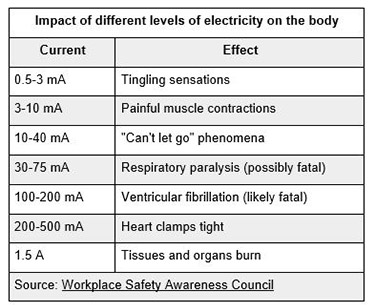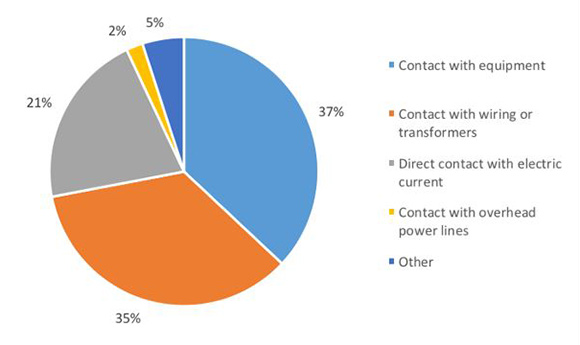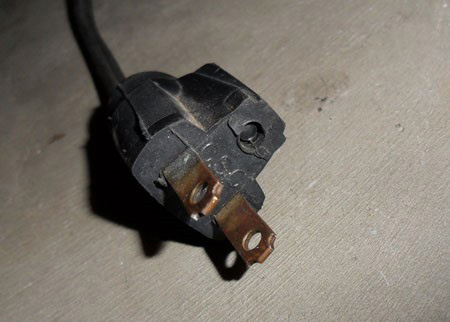
How to Ground Electrical Safety in Your Business
It’s easy for people who work with electricity and electrical equipment every day to forget how dangerous it can be. They often become complacent about staying safe.
At a minimum, improper contact with electrical elements can cause minor shocks and burns. At the extreme, it leads to major injuries, including loss of hearing, heart and lung damage, and even death.

In addition, if an employee gets injured on the job or at your workplace, it could expose your business to costly workers’ compensation, insurance, and legal issues.
In this article, we offer tips that you can pass on to your employees and co-workers that will keep them safe on the job, whether it’s an indoor or outdoor construction site, mining operation, entertainment venue, or other location.
We’ve divided this information into four categories:
- Extension cord and electrical cable safety
- Ground-fault protection
- Importance of using grounded equipment
- Using equipment correctly
It’s a good idea to share this safety information with your employees frequently. Try these methods:
- Team meetings
- Workplace intranet site, company blog or email
- Bulletin board posts
- Flyers, handouts, and checklists
Most Common Causes of Electrical Injuries on Worksites

Source: The Fire Protection Research Foundation
1. Extension cord and electrical cable safety
Items as simple as extension cords or other electrical cables often cause significant injury or damage at a work site. Normal wear and tear can loosen or expose wires, creating possible hazards. Cords that are not three-wire type, not designed for hard usage (made from modern, highly durable materials), or have been modified increase the risk of conducting electrical current.
In addition, cords and cables that are not properly fixed to the floor can lead to trips, falls, and other accidents.

Tips
Share these tips on how to reduce electrical cord and cable-related accidents with your employees.
- Use cords and cables manufactured for professional use with the latest materials and methods. A reputable supplier can recommend the right ones for the job.
- Never used cabling that’s been cobbled together. (If customized materials are required, have them manufactured by a professional firm.)
- Only use three-wire extension cords. Two-wire cords should never be used on a job site.
- Use extension cords that are labeled for hard or extra-hard usage.
- Use cords, connection devices, and fittings equipped with strain relief. (This includes high-quality, stress-tested spider boxes.)
- Double check that the proper cords and cables are matched with equipment.
- Remove cords properly, by pulling on the plugs or end-connectors, not the cords. This will extend their life.
- Store items properly to prevent damage. Use industrial-level storage equipment, including carts, cabinets, and hangers.
- Continually inspect cords and cables. Those that are damaged, not marked for hard or extra-hard use, or that have been modified must be taken out of service immediately. Replace them with newer modern models.
- Tape cords to the floor to prevent trips or falls. Use tape and adhesive materials manufactured for this purpose – never nails or staples, which can cause damage to cords.
Note: Your firm should be using the latest rubber cord products. Cords have evolved significantly over time. If you’ve been using the same ones for years, you could be missing out on some important safety features.
The latest rubber cords carry a full range of listings and certifications from exacting safety organizations. In addition, many products meet or exceed the requirements of OSHA, MSHA, RoHS, and other industry standards. These products are:
- Water resistant
- Sunlight resistant
- Designed to be used in severe environmental conditions
- Able to withstand exposure to oil, acids, alkylates, heat, flame, moisture, and chemicals.
If you’re not using these, you could be compromising the safety of your employees.
2. Ground-fault protection
Contracting, construction, mining, and installation work causes wear and tear that can result in insulation breaks, short circuits, and exposed wires, especially on flexible cable and power tool cords. If your employees don’t use ground-fault protection, small breaks, tears, or short circuits can cause a ground-fault that could send current through a worker’s body. This usually causes electrical burns and can lead to death.
Tips
Share this information with your employees:
- Use ground-fault circuit interrupters (GFCIs) on all 120-volt, single-phase, 15- and 20-ampere receptacles. Regularly test them following the manufacturer’s recommended procedures to ensure they’re working correctly.
- If your company has one, always follow its assured equipment grounding conductor program (AEGCP).
- Only use double-insulated tools and equipment. Make sure these tools are clearly marked, and follow the instructions that come with them. (One of the biggest causes of workplace incidents is using tools incorrectly or pushing them beyond recommended limits.)
- Make it a regular practice to inspect all electrical equipment before use. Equipment with frayed cords, missing ground prongs, cracked tool casings, or other damage should never be used. Clearly label any damaged or defective tools or cables, and do not use them until they have been repaired. If they can’t be repaired, carefully dispose of them so there’s no chance anyone could work with them by accident.
Interested in more employee safety training information? This train-the-trainer guide from Workplace Safety Awareness Council could help take your employee safety program to the next level.
3. Importance of using grounded equipment
If the power supply to any electrical equipment being used at a work site isn’t grounded (or if the path has been broken), electrical current could travel through a worker’s body, leading to burns or death.

Tips
- Ensure all power supply systems, electrical circuits, and electrical equipment are grounded. Never use anything without proper grounding.
- Inspect all supplies before use. If the grounding is broken or defective, take it out of service immediately and get it repaired or permanently discard it. Also, regularly inspect everything to ensure that the path to ground in all electrical systems is continuous.
- Never remove ground prongs from equipment or extension cords.
- Ground all exposed metal equipment parts.
- Ground the metal parts of non-electrical equipment, including:
- frames and tracks of electrically operated cranes
- frames of non-electrically driven elevator cars to which electric conductors are attached
- hand-operated metal shifting ropes or cables of electric elevators
- metal partitions, grill work, and enclosures around equipment of over 1kV between conductors
Note: If your firm has been using the same connectors for a long time, you owe it to yourself to check out newer, more innovative options, including pin connectors with Phenolic or thermal-resistant nylon bodies. Products like these have become the industry standard. In addition, the extreme temperature-tolerant design allows these connectors to perform up to higher standards in more challenging environments.
4. Using equipment correctly

If electrical equipment is used improperly or to do things it’s not designed to do, it could override the manufacturer’s safety features. This could damage the equipment and more importantly, cause employee injuries.
Reminders
Consistently remind your employees that these are improper ways to use equipment:
- Adding power cables to multi-receptacle boxes and using them as extension cords
- Creating extension cords with ROMEX wire
- Using equipment labeled for indoor use in outdoor locations
- Attaching ungrounded, two-prong adapter plugs to grounded three-prong cords and tools
- Using circuit breakers or fuses with the wrong rating for over-current protection
- Using cords or tools that have been modified or changed
- Using cords or tools with worn insulation or exposed wires
Tips
Share this information on proper electrical equipment use:
- Always work with equipment that meets or exceeds OSHA standards, especially outdoors or in damp or high-stress locations like mines or busy construction sites.
- Use the right portable power supply for the job.
- Use all equipment according to the manufacturer’s instructions. Never use it for unintended purposes, exceed its limits, or modify it.
- Don’t modify cords (patch two cords together) or use them incorrectly.
- Always use the latest, highest quality protective gear, including gloves, coveralls, and eye glasses.
Note: If your company must alter equipment or fabricate tools or equipment in your shop, make sure it’s in compliance. Or turn to company that has experience fabricating safe customized assemblies.
Check it out: OSHA offers a checklist of how to use power tools correctly. Share it with your employees.
Conclusion
Employees who work around electrical power all the time can become complacent about its dangers. This can lead to property damage, injuries, and death. It could also cost your company if you’re sued for negligence.
You owe it to your employees to educate them on electrical power safety and to keep the importance of staying safe top of mind. Regularly review these safety tips and other regulations.
Want to learn more about this important topic? The Centers for Disease Control offers many helpful publications on electrical safety in the workplace.



 CALL OR TEXT NOW 800-597-9311
CALL OR TEXT NOW 800-597-9311
Leave a comment